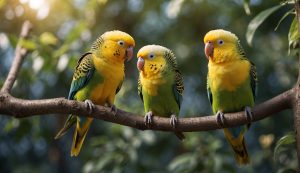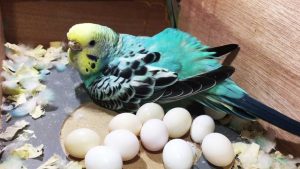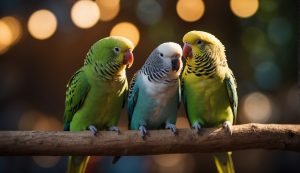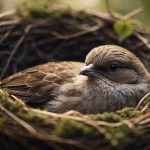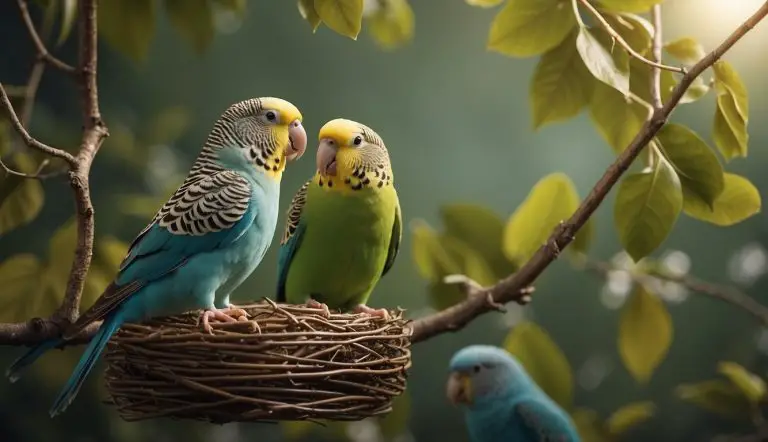What Does a Parakeet Sound Like? Understanding Their Vocalizations

Parakeets, with their capacity for a wide range of vocalizations, have charmed their way into the homes and hearts of many as colorful and social companions.
The sound of a parakeet is quite distinctive; a single bird can chirp, sing, and even mimic human speech or environmental sounds. These vocal displays are not just for entertainment; they serve as a means of communication between birds and often reflect their emotional states or social dynamics.
A parakeet’s call, complete with a repertoire of notes, can indicate contentment, hunger, excitement, or even distress.
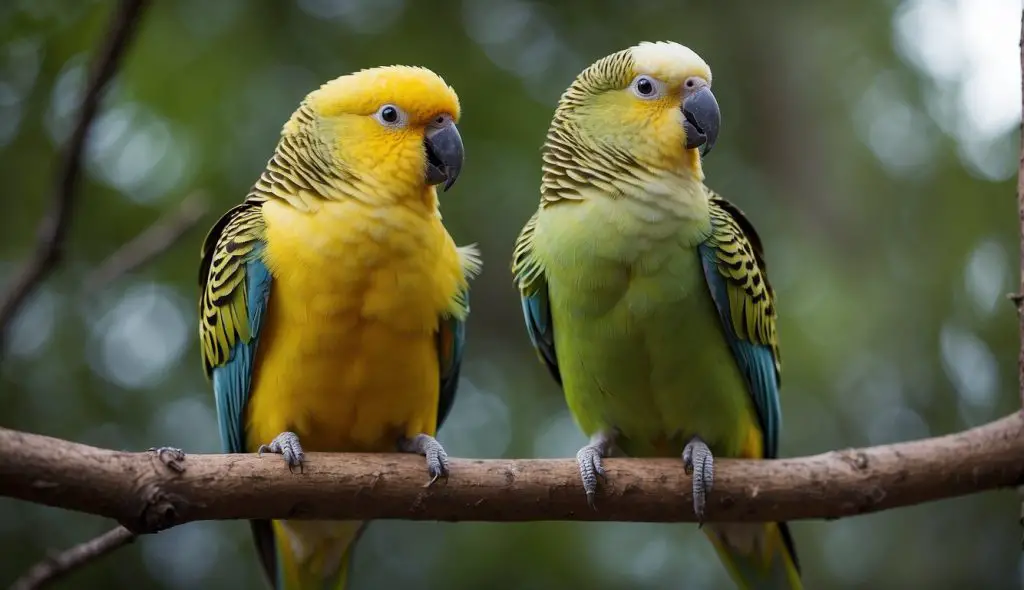
Their communication also aids in strengthening bonds within their flock, which can now extend to their human family members.
Understanding and responding to these vocalizations can enhance the human-parakeet interaction experience. Much like learning a new language, tuning into the nuances of parakeet sounds can lead to a deeper connection between you and your feathered friend.
Recognizing the context and frequency of these sounds can be a vital part of ensuring the parakeet’s well-being, reflecting their health and happiness within their environment.
Key Points
- Parakeet vocalizations are varied and communicate their emotional states.
- The context of a parakeet’s sounds can indicate their needs and well-being.
- Responding appropriately to parakeet calls can strengthen the bond between you and your bird.
Table of Contents
Understanding Parakeet Vocalizations
Parakeets possess a rich array of vocalizations that they use to communicate with one another. As a keen listener, I’ve learned to interpret their different sounds and appreciate their complex language.
Common Parakeet Sounds
I’ve discovered that parakeets produce a variety of sounds that can be broadly categorized. The most frequent sounds include:
- Chirping: A soft, repetitive note which can signal contentment.
- Chattering: A more complex set of notes that often indicates excitement or the presence of a social interaction.
- Whistling: Clear, melodious tones that may be used in courtship or simply as a form of self-entertainment.
- Singing: A series of varied notes strung together in what resembles a song.
- Call: Distinctive sounds used to grab attention or signal something specific.
Deciphering Parakeet Chirps and Calls
Parakeets use their vocalizations not just to talk but to engage in meaningful conversation with both their kin and human companions. Here’s how I interpret their language:
- Chirps and Tweets: Standard forms of parakeet communication, often denoting general well-being.
- Conversational Chatter: When my parakeet chatters with varying intensity, it’s usually trying to engage with me or its reflection.
- Urgent Calls: A louder, more insistent call can indicate distress or a desire for immediate attention.
By tuning into the specific patterns and contexts of these sounds, I better understand my parakeet’s moods and needs.
Indicators of Emotional States
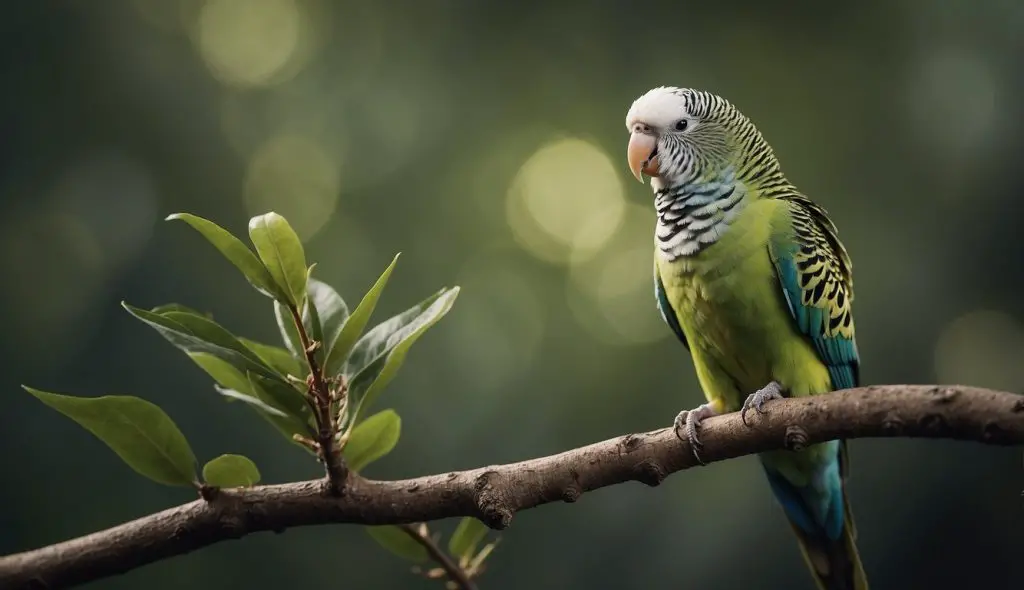
In my experience with parakeets, their vocalizations and behaviors can be quite expressive, revealing much about their emotional states. Observing and understanding these cues can help me ensure their well-being.
Sounds of Contentment and Happiness
When my parakeet is happy and content, it typically exhibits a soft and melodious chirping. This pleasant sound can vary in pitch and frequency but is generally musical in nature, indicating a relaxed and comfortable state.
In addition to chirping, a content parakeet might engage in beak grinding, which is a soft, repetitive sound that I often hear when a bird is settling down to rest or sleep. It’s akin to a cat’s purr and suggests a deep sense of peace and safety.
Signs of Stress or Distress
Conversely, when my parakeet experiences stress, fear, or distress, it emits very different sounds. Squawking, loud and repetitive screaming, and panicked chirps are all auditory signs that my parakeet is uncomfortable or scared.
These sounds are often higher in pitch and more erratic than the soothing chirps of happiness. If I hear these vocalizations, I know to check for any potential stressors in the environment, such as abrupt changes or perceived threats, and work to alleviate my parakeet’s discomfort.
Behavioral Context of Parakeet Sounds
Parakeets exhibit a delightful variety of sounds that are significantly influenced by their behavior in different contexts. These vocalizations can serve as vital indicators of their needs and states, especially during feeding and breeding, or as they interact with their environment and social circle.
Sounds Parakeet Make During Feeding and Breeding
During feeding times, you can hear soft chirps and tweets as they communicate contentment or call out to other flock members to signal the presence of food.
My perception of their chatter is that it helps maintain social order and ensure all flock members are aware of the food source.
During the breeding season, vocalizations take on a different note; they become more frequent and complex as hormones play a significant role.
Males may sing louder and more elaborately to attract a mate, while females might emit softer calls to signal receptiveness.
Environmental and Social Influences
The environment plays a crucial role in the sounds a parakeet makes. A comfortable and stimulating environment, complete with water, toys, and perhaps a swing, leads to vocalizations that indicate happiness or playfulness.
Conversely, if they feel threatened or their personal space is intruded upon, you might hear louder, more aggressive squawks.
Socially, parakeets use their voices to establish relationships, maintain flock cohesion, and even to assert dominance or submission. Depending on the social context, whether in a small group or a large flock, their calls can change to reflect their interaction with others and the surrounding environment.
Interactions and Bonding
As a pet parakeet owner, I’ve observed that the way parakeets interact and form bonds is truly intricate, involving a range of vocalizations to communicate with their flock and human companions. https://www.youtube.com/embed/On3UFAQ_G4E
Communicating with Pet Owners
I’ve found that when I pay attention to my pet parakeet, it sometimes tries to communicate. Parakeets can learn to sing and, impressively, even mimic human speech.
Some owners, including myself, teach our pet birds to talk by repeatedly saying words or phrases. However, it’s their way of showing affection and interacting that truly reflects their bond with us.
Below is a list of common sounds and what they might mean:
- Chirping: Happy or seeking attention
- Talking/Singing: Content and engaged; sometimes mimicking their owners
- Clicking Noises: Signaling interest or enjoyment
Inter-Parakeet Communication
My observations have shown me that interacting among themselves is equally fascinating. Parakeets often form strong bonds and communicate through various calls that convey different messages.
This interaction often strengthens their connections within the flock. For instance:
- Contact Calls: Maintain connection over a distance with their flock or bonded pairs
- Distress Calls: Signal alarm or discomfort to the flock
In the space of their little world, these interactions serve as the backbone of their social structure. Whether it’s two parakeets in a home or several in an aviary, they share a detailed and intimate language that solidifies their communal bonds.
Health and Environmental Factors
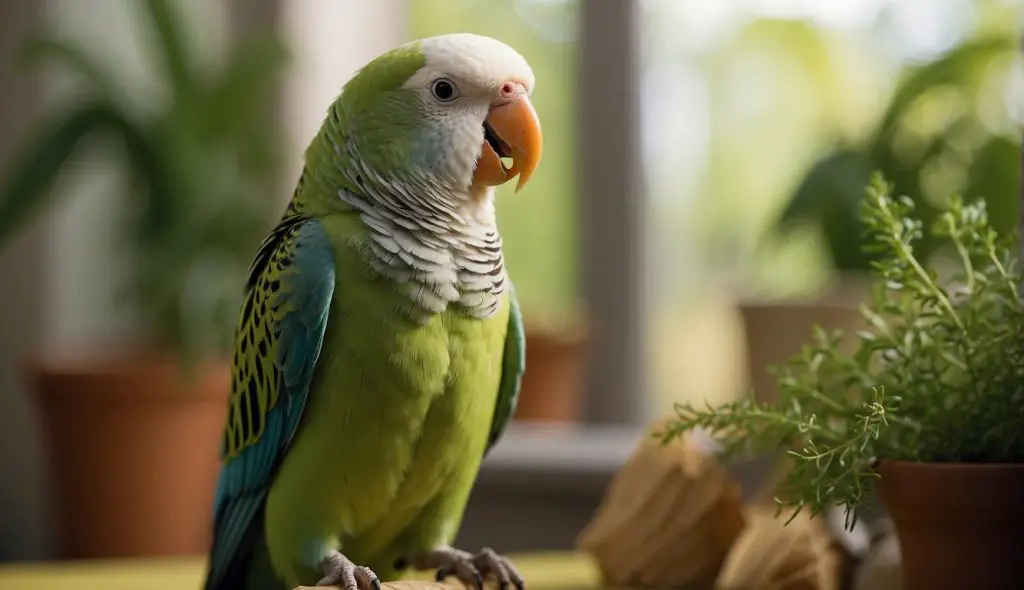
When understanding parakeet vocalizations, it’s crucial to consider how their health and environment impact their sounds. Environmental factors like habitat conditions and diet strongly influence their communication.
Effects of the Habitat and Diet
My parakeet’s habitat plays a significant role in its health and vocalizations. A well-maintained environment with ample space for exercise is critical.
I make sure my parakeet has room for flying and activities such as wing flapping, which is essential for their physical health. An overcrowded or unclean habitat can lead to stress and health issues, which may result in less singing and more distress calls.
Ensuring a balanced diet is also paramount for my parakeet’s vocal health. A diet lacking in essential nutrients can cause health issues, which might manifest in changes in their singing patterns.
Additionally, dietary deficiencies can weaken a parakeet’s immune system, making them more susceptible to illness.
- Proper Habitat Maintenance:
- Spacious cage and flight space
- Regular cage cleaning
- Safe perches, avoiding dislodged perches
- Balanced Diet:
- Variety of seeds, pellets, fruits, and vegetables
- Clean and fresh water daily
- Avoiding an all-seed diet to prevent malnutrition
Responding to Potential Threats
In terms of vocalizations, my parakeet might exhibit alarm calls when it feels threatened or experiences pain. These calls can be loud and shrill. Potential threats can vary from the sight of a predator outside the cage to a sudden loud noise.
Recognizing these sounds helps me ensure my parakeet’s safety and comfort.
Moreover, defensive behaviors such as hissing or aggressive wing flapping could accompany these vocal responses, signaling fear or the need for a nap if they’re annoyed.
When nighttime comes, I cover the cage to provide a sense of security for my parakeet and to minimize the chances of being startled. It’s my responsibility to monitor body language along with vocal cues to determine if my parakeet feels safe in its environment.
- Indicators of Fear or Pain:
- Loud, shrill alarm calls
- Hissing when approached
- Aggressive wing flapping
- Creating a Safe Environment:
- Monitoring for signs of predators or threats
- Covering the cage at night for security
- Providing a stable and tranquil environment
Understanding and Responding to Parakeet Sounds
When I think about parakeet sounds, it’s a delightful mix of chirps, trills, and chatter that come to mind.
Learning to communicate with my feathered friends involves attuning my ear to the nuances of their vocalizations.
Parakeets use a wide range of calls to convey different emotions or desires, and recognizing these can enhance our mutual understanding.
- Contact calls may sound like chirruping, and are a way for parakeets to establish connection with their flock or with me.
- When my parakeet chirrups, it’s usually a sign they want to interact or they’re simply acknowledging my presence.
- Chiding sounds or louder repetitive chirps can indicate annoyance or discomfort. If I hear this, I check for any problems in their environment.
- Hissing usually signifies that my parakeet is frightened or feeling threatened. Giving them space and addressing the source of distress helps alleviate their fear.
Parakeets also enjoy mimicking sounds. With patience, I can teach them to reproduce simple words or whistle tunes.
This ability to mimic often resembles a mumbled conversation or even music to our human ears.
Trills and soft coos may accompany content moments, often when they are wooing a mate or feeling relaxed. Recognizing these sounds allows me to respond appropriately, whether it’s providing attention or letting them enjoy some tranquility.
Understanding my parakeet’s sounds is a continuous journey. By paying close attention and associating their sounds with their behavior, I strengthen our bond and ensure their well-being.
Frequently Asked Questions
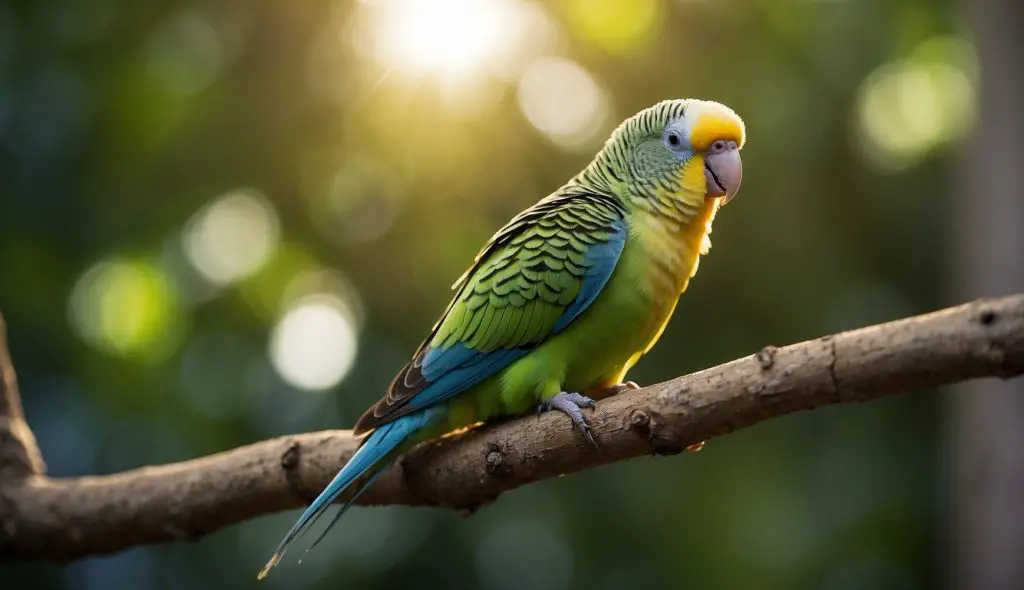
In this section, I’ll address some common curiosities regarding parakeet vocalizations to help parakeet owners understand their feathered friends better.
How can I tell if my parakeet is happy based on its sounds?
I notice that when a parakeet chirps softly and melodically, it usually means they’re content and happy.
A series of chirps while they’re playing or interacting with their toys is a good sign of their joyful state.
What are the common sounds that indicate a parakeet is content?
My parakeet often makes gentle, soothing tweets and chirps when it’s feeling content.
When it grinds its beak, which often sounds like a soft clicking noise, it’s a sign of relaxation, akin to a cat purring.
Can you describe the variety of sounds a female parakeet makes?
Female parakeets can be quite vocal, producing a range of chirps, squawks, and chattering sounds.
Often, they may be quieter than males and their chirps shorter, but they express themselves through a repertoire of vocalizations, especially during social interactions.
What do wild parakeet vocalizations typically sound like?
In the wild, parakeets’ vocalizations are diverse, often loud and used to communicate with the flock over long distances.
Their calls can be sharp and repetitive, possibly serving as alarms or contact calls to maintain the group’s cohesion.
How do budgies communicate with each other through sound?
Budgies often communicate through chirps and tweets of varying pitches and lengths, which can convey different messages, such as alarm, contentment, or the desire for interaction.
They might chatter or sing in the presence of their flockmates as a sign of social bonding or when they’re feeling playful.
What is the method for calling a parakeet using sound?
I’ve found that mimicking my parakeet’s chirps or speaking in a soft, high-pitched voice can be an effective way to call and engage with them.
Consistently using the same sound or word when it’s time for food or play can also train them to come when called.

